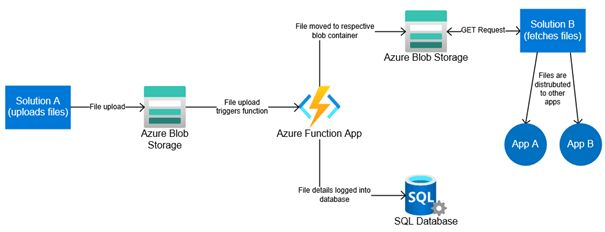Discover how an integration developer uses Azure function apps
Author: Cristel Capetillo Hernandez
As an Integration Solutions Developer at Vattenfall, I encounter new and exciting challenges every day, where I get to solve problems using different technologies. Azure Function App is one of these technologies. Today, I want to take you on a journey on how we use it to connect systems, manage data, and improve business processes, all while working within an Agile team environment.

Why integration is important
In today’s world, systems and applications need to talk to each other efficiently. This is where integration comes in—it ensures that data flows smoothly between different systems, helping businesses run seamlessly. Integration is the backbone of modern digital operations, and at Vattenfall, we make sure everything works in harmony by using tools like Azure Function Apps.

Why use Azure Function Apps?
Azure Function Apps are part of a “serverless” cloud architecture, meaning we don’t have to worry about managing servers or hardware. Instead, we can focus on what matters: building and deploying the solutions that connect systems. Function Apps are lightweight, scalable, and cost-effective, making them perfect for efficient handling of data between different systems. Here are some of the key benefits when using Function Apps:
-Scalability: Automatically scales based on the workload, handling traffic spikes effortlessly.
-Cost-Efficiency: You only pay for what you use, making it budget-friendly for dynamic workloads.
-Integration-Friendly: Seamlessly integrates with other Azure services like Blob Storage, Event Grid, and Azure SQL databases.

How it works
Recently, our team tackled a project that required two large systems to communicate with each other and to handle significant amounts of data. Solution A would collect large data files, and Solution B needed to distribute them. Our goal was to move this data quickly and securely, while also keeping a record of the files in a database for tracking purposes. Here’s how we used Azure Function Apps to do it:
Solution A drops files into an Azure Blob Storage account When a file is uploaded, it triggers an Azure Function App. The Function App moves the files to their proper locations in Blob Storage and logs each file’s details in an Azure SQL database. Solution B (an API) then picks up the files via a GET request to distribute them further to other applications. This entire process happens in real time, making sure data moves quickly and efficiently between the two systems, even when handling large volumes of information.
If you are curious what this looks like in practice , see the diagram

Why this approach works
Using Azure Function Apps allows us to break down complex processes into simple, manageable steps. We can develop and update small pieces of code quickly, which means our team can adapt to changes faster. Plus, since Function Apps scale automatically based on demand, we only pay for what we use—this keeps costs down while ensuring the system can handle traffic spikes. Another key benefit is the seamless integration with other Azure services, like Blob Storage and SQL databases, which lets us manage everything from one platform. This makes it easier to maintain and update our solutions.
Agile teamwork
In Vattenfall’s integration department, we work in Agile teams, where collaboration is at the core of everything we do. We hold regular meetings to assess progress, adjust priorities, and ensure that the solutions we build are truly meeting the needs of the business. The flexibility of Azure Function Apps fits perfectly into our Agile workflow because it allows us to iterate quickly and make improvements without rebuilding entire systems.
This is where the journey ends, I hope you found it interesting and that by now you can understand a bit more of what “integration” means and how we make it happen with the help of technologies like the Azure Function App.
Receive more articles like this

Related articles

Teaser
General BusinessContent Type
NewsPublish date
12/11/2025
Summary
New office in PolandA major milestone for Vattenfall in Poland: the new office at Grundmanna Office Park in Katowice will serve as the new place of work for almost 500 professionals. St

by
Przemysław Dana

Teaser
Trading & MarketsContent Type
BlogPublish date
11/05/2025
Summary
Meet Yunji SchusterYunji Schuster’s career journey spans continents and industries, blending global experience with a passion for adaptability. After earning dual degrees—a Bachelor of Business

Teaser
NuclearContent Type
BlogPublish date
10/31/2025
Summary
Meet Evelina WikstenWhen Evelina walks into work, no two days look the same. One moment she’s planning complex projects, the next she’s writing technical reports - or stepping into the reactor h

Teaser
General BusinessContent Type
NewsPublish date
10/27/2025
Summary
ShipIT 2025 HackathonThis year’s Vattenfall IT’s flagship event delivered not only creative AI solutions but also heartfelt generosity. For two days (Sept 30/Oct 1) Hamburg office became the hub

by
Przemysław Dana

Teaser
General BusinessContent Type
NewsPublish date
10/08/2025
Summary
HackathonThis autumn, Vattenfall is proud to partner with Consid for Considition 2025, a global hackathon focused on solving real-world challenges. This year’s theme centers on optimizing electr

by
Przemysław Dana
.jpg)
Teaser
General BusinessContent Type
BlogPublish date
10/03/2025
Summary
Meet Anna MajerFrom law student to IT leader, Anna’s journey at Vattenfall is a story of curiosity, courage, and continuous growth. In this interview, she shares how she transitioned into tech w
.png)
Teaser
WindContent Type
BlogPublish date
10/03/2025
Summary
Meet Robin VanderheijdenAfter years at sea and in offshore oil and gas, Robin found his calling in the wind. In this personal story, he shares what it’s like to work on one of the Netherlands’ l

Teaser
General BusinessContent Type
BlogPublish date
07/01/2025
Summary
Author: Krzysztof Brawański, Credits to Jacek Gzel, co-creator of the seriesIn the second round, we want to focus on creating view actions and dynamically changing data depending on the state of

by
Przemysław Dana
.png)
Teaser
E-MobilityContent Type
BlogPublish date
05/30/2025
Summary
Author: Jacek Gzel, Credits to Krzysztof Brawański, co-creator of the seriesIn Vattenfall, we are working in a cross-functional team responsible for the whole smart-charging electric vehicles fe

by
Przemysław Dana

Teaser
General BusinessContent Type
BlogPublish date
05/27/2025
Summary
Author: Jakub StawiarskiTypeScript’s type safety and object-oriented features made it quite simple for web developers accustomed to languages such as Java or C# to start using it. I experienced